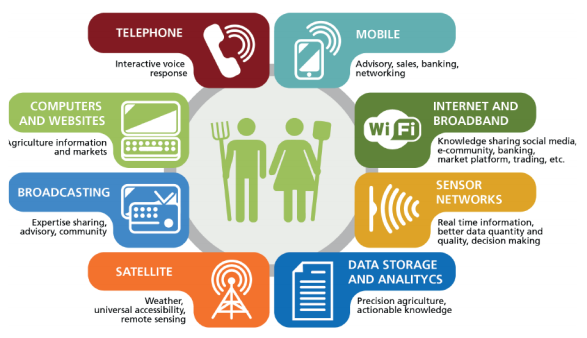Service delivery models
In order to have a successful product, the services should be delivered to the end-users in a sustainable manner. Reaching the food producers is a process that consist of different steps: 1. making farmers aware of the existence of the product (awareness creation) [1]; 2. demonstrating the services (training) [2]; 3. convincing farmers that the benefits outweigh the costs and providing a low level entry (promotional) [3]; 4. delivering the actual service to the farmer (knowledge sharing and technology transfer) [4]. ICT tools can play an important role in most of these steps. The role of ICT tools in providing training is still limited due to the clear benefits of the ‘seeing is believing’ concept in training on new agronomic practices.

GEO-ICT Framework. Source: FAO-ITU. Adapted from E-Agriculture Strategy Guide: Piloted in Asia-Pacific Countries
Marketing
The socio-economic context is crucial in adoption and success of digital agriculture [4]. Marketing should be done through channels that are used by the target audience. This can be tv, radio, mouth-to-mouth, social media or others. Entertainment-education [5] is often used to educate farmers on improved agronomic practices. It is very important that the marketing and service delivery approach takes into account the differences in access by gender and age, to ensure digital inclusiveness [6].
Service type
Delivery of the actual service should take numerous issues into account. This includes access to mobile (smart) phone [8], connectivity in rural areas, nature of interaction with the users, local (digital) literacy levels [9], revenue models, and more. Advice that takes into account plot-specific data, such as sowing date and variety (farmer input) will have to be made available directly to the farmer, while more general advice such as weather forecasts can be delivered on mass media (tv, radio). Taking into account farmer feedback (two-way communication [10]) can improve services, but limits the choice of technologies.
Quantity vs. quality is an important trade-off in service delivery. Mass-media such as websites, tv and radio can easily reach large numbers, but are not channels that facilitate interactions (including financial transactions). This is why these channels are generally used for awareness creation rather than actual service delivery. Mobile phones are the most used technology in service delivery [11]: depending on the service this can be through mobile-apps, SMS messages, voice messages or by calling call centres.
Social media platforms can combine the benefits of reaching large numbers with the location-specific information provided through apps. Charging for a service (B2C) is relatively easy when using mobile phones. The downside is that farmers might be hesitant to pay for individual services. This is the reason why many of the created services have been integrated into existing products (using a B2B approach): existing marketing and service delivery approaches can be used that are familiar to the farmers. Bundling of services can provide the target group with more flexibility to select the services they require and are willing to pay for. In order to bundle services, the service delivery method should facilitate this additional complexity. Apps and dashboards on smartphones/tables provide a better technological framework for bundling than mobile phones. This also includes the ability to integrate map viewers.
G4AW results
The service delivery method that is most used in G4AW is by text messages (67%), followed by apps and web portals (50%) , face-to-face (33%) and call-centres (20%). Using voice messages (USSD) and radio to deliver the services is only done in 3 out of the 25 G4AW projects. Many projects use more than one data transmission approach to market and deliver the service.
Read more:
- Solving the agtech marketing challenges.
- Agriculture ICT Extension Services.
- Six business model recommendations for ACP digital agribusiness entrepreneurs.
- A review of social science on digital agriculture, smart farming and agriculture 0: New contributions and a future research agenda.
- Entertainment–education and rice pest management: A radio soap opera in Vietnam.
- Agricultural services and digital inclusion.
- https://www.kit.nl/wp-content/uploads/2019/10/KIT_WP2016-4_Harnessing-ICT-for-agricultural-extension.pdf
- Smartphone Ownership Is Growing Rapidly Around the World, but Not Always Equally.
- Reviewing 20 years of ICT in ACP agriculture.
- Crowdsourcing for agricultural applications: A review of uses and opportunities for a farmsourcing approach.
- GSMA AgriTech Programme